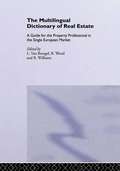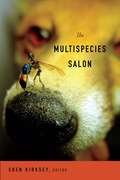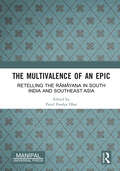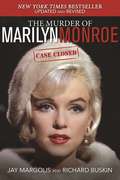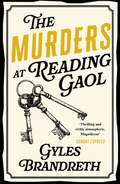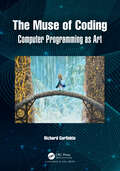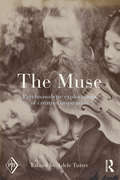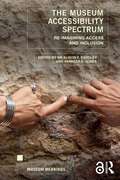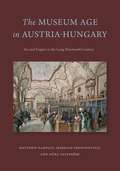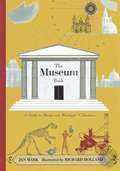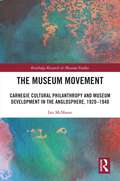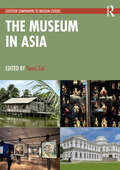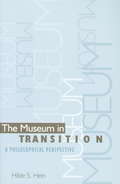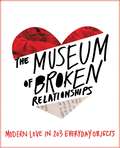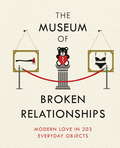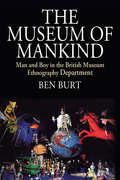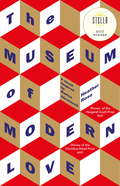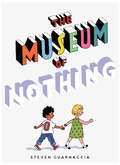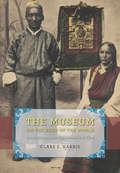- Table View
- List View
The Multilingual Dictionary of Real Estate: A guide for the property professional in the Single European Market
by Bernadette C Williams R. Williams B. Wood L. van BreugelThe Multilingual Dictionary of Real Estate" is not simply a word-for-word dictionary of specialist and technical terminology. It offers explanations of terms which cannot be translated exactly or are liable to cause confusion. A supplementary section of the dictionary provides detailed notes as well as translations of particularly tricky terms. There are also invaluable sections outlining the real estate and planning systems in the different European countries, government and planning hierarchies and real estate associations throughout Europe.
The Multispecies Salon
by Eben KirkseyA new approach to writing culture has arrived: multispecies ethnography. Plants, animals, fungi, and microbes appear alongside humans in this singular book about natural and cultural history. Anthropologists have collaborated with artists and biological scientists to illuminate how diverse organisms are entangled in political, economic, and cultural systems. Contributions from influential writers and scholars, such as Dorion Sagan, Karen Barad, Donna Haraway, and Anna Lowenhaupt Tsing, are featured along with essays by emergent artists and cultural anthropologists.Delectable mushrooms flourishing in the aftermath of ecological disaster, microbial cultures enlivening the politics and value of food, and nascent life forms running wild in the age of biotechnology all figure in this curated collection of essays and artifacts. Recipes provide instructions on how to cook acorn mush, make cheese out of human milk, and enliven forests after they have been clear-cut. The Multispecies Salon investigates messianic dreams, environmental nightmares, and modest sites of biocultural hope.For additional materials see the companion website: www.multispecies-salon.org/Contributors. Karen Barad, Caitlin Berrigan, Karin Bolender, Maria Brodine, Brandon Costelloe-Kuehn, David S. Edmunds, Christine Hamilton, Donna J. Haraway, Stefan Helmreich, Angela James, Lindsay Kelley, Eben Kirksey, Linda Noel, Heather Paxson, Nathan Rich, Anna Rodriguez, Dorion Sagan, Craig Schuetze, Nicholas Shapiro, Miriam Simun, Kim TallBear, Anna Lowenhaupt Tsing
The Multivalence of an Epic: Retelling the Rāmāyaṇa in South India and Southeast Asia
by Parul Pandya DharThis volume examines The Rāmāyaṇa traditions of South India and Southeast Asia. Bringing together 19 well-known scholars in Rāmāyaṇa studies from Cambodia, Canada, France, India, Indonesia, Malaysia, Singapore, Thailand, UK, and USA, this thought-provoking and elegantly illustrated volume engages with the inherent plurality, diversity, and adaptability of the Rāmāyaṇa in changing socio-political, religious, and cultural contexts. The journey and localization of the Rāmāyaṇa is explored in its manifold expressions – from classical to folk, from temples and palaces to theatres and by-lanes in cities and villages, and from ancient to modern times. Regional Rāmāyaṇas from different parts of South India and Southeast Asia are placed in deliberate juxtaposition to enable a historically informed discussion of their connected pasts across land and seas. The three parts of this volume, organized as visual, literary, and performance cultures, discuss the sculpted, painted, inscribed, written, recited, and performed Rāmāyaṇas. A related emphasis is on the way boundaries of medium and genre have been crossed in the visual, literary, and performed representations of the Rāmāyaṇa. Print edition not for sale in South Asia (India, Sri Lanka, Nepal, Bangladesh, Pakistan and Bhutan)
The Mummy (Devil's Advocates)
by Doris V. SutherlandReleased in 1932, The Mummy moved Universal horror away from the Gothic Europe of Dracula and Frankenstein and into a land of deserts, pyramids, and long-lost tombs. In doing so the film continued a tradition of horror fiction that is almost as old as the Western pursuit of Egyptology, as numerous European and American authors from the nineteenth and early twentieth centuries had portrayed Egypt as a place of mystery and magic. This book examines the roots of The Mummy. It shows how the film shares many of its motifs with the work of writers such as Bram Stoker, Arthur Conan Doyle, and H. Rider Haggard, whose tales of living mummies, immortal sorcerers, and Egyptian mysticism bear strong resemblances to Universal’s movie. In addition, the book discusses how The Mummy drew upon a contemporary vogue for all things ancient Egyptian: the tomb of Tutankhamun was discovered the decade before the film was released, prompting sensationalistic rumors of a curse. This is the story of what happened when Hollywood horror went to Egypt.
The Muppets Official Crochet Amigurumi
by Drew HillWelcome to The Muppet Theatre, where you&’re just in time for a very special performance. It&’s the Amigurumi Muppets, with their very special guest: you! For the first time ever, you can crochet your favorite characters, from Kermit the Frog and Fozzie Bear to Swedish Chef and Pepé the King Prawn – and yes, even Miss Piggy!After 70 years of singing and dancing and making people happy, The Muppets are ready to tackle their next wacky performance: getting hooked on crochet! With The Muppets Official Crochet Amigurumi, you can now crochet your own Muppet amigurumi figures, and the whole gang is here – Kermit the Frog, Fozzie Bear, Miss Piggy, Beaker and Dr. Bunsen Honeydew, Animal, Gonzo, even Pepé the King Prawn and Rizzo the Rat! Each of these fifteen projects is a fully articulated doll, right down to Animal&’s wild hair and Kermit&’s pointed collar. With easy-to-follow patterns, and some jokes and fun from The Muppets themselves, The Muppets Official Crochet Amigurumi will have you ready to put on a show with all your favorite characters. MORE THAN A DOZEN of the most cherished Muppets are featured in The Muppets Official Crochet Amigurumi, including Kermit, Miss Piggy, Fozzie Bear, Animal, Gonzo, and more! EXCLUSIVE MATERIAL: This is the first officially licensed crochet book featuring the Muppets.
The Mural at the Waverly Inn: A Portrait of Greenwich Village Bohemians
by Dorothy Gallagher Edward SorelSorel--whose caricatures and drawings regularly appear in The New Yorker and on its cover--chose forty Greenwich Village greats from the past 150 years to cavort in bacchanalian splendor. Each of the 40 makes a solo appearance in these pages alongside a charming, telling vignette of his or her life by Dorothy Gallagher, then appears in a foldout of the entire mural at the back of the book.
The Murder of Marilyn Monroe: Case Closed
by Richard Buskin Jay MargolisA New York Times Best Seller!Since Marilyn Monroe died among suspicious circumstances on the night of August 4, 1962, there have been queries and theories, allegations and investigations, but no definitive evidence about precisely what happened and who was involved . . . until now. In The Murder of Marilyn Monroe: Case Closed, renowned MM expert Jay Margolis and New York Times bestselling author Richard Buskin finally lay to rest more than fifty years of wild speculation and misguided assertions by actually naming, for the first time, the screen goddess’s killer while utilizing the testimony of eye-witnesses to exactly what took place inside her house on Fifth Helena Drive in Los Angeles’ Brentwood neighborhood.Implicating Bobby Kennedy in the commission of Marilyn’s murder, this is the first book to name the LAPD officers who accompanied the US Attorney General to her home, provide details about how the Kennedys used bribes to silence one of the ambulance drivers, and specify how the subsequent cover-up was aided by a noted pathologist’s outrageous lies. This blockbuster volume blows the lid off the world’s most notorious and talked-about celebrity death, and in the process exposes not only the truth about an iconic star’s tragic final hours, but also how a legendary American politician used powerful resources to protect what many still perceive as his untarnished reputation.Skyhorse Publishing, as well as our Arcade imprint, are proud to publish a broad range of books for readers interested in history--books about World War II, the Third Reich, Hitler and his henchmen, the JFK assassination, conspiracies, the American Civil War, the American Revolution, gladiators, Vikings, ancient Rome, medieval times, the old West, and much more. While not every title we publish becomes a national bestseller, we are committed to books on subjects that are sometimes overlooked and to authors whose work might not otherwise find a home.
The Murders at Reading Gaol: The Victorian Murder Mystery Series: 6 (The Victorian Murder Mystery Series #6)
by Gyles Brandreth'Fantastic! Read this within a day, couldn't put it down!' Reader review ⭐⭐⭐⭐⭐'Marvellous . . . with a twist at the end you will never see coming. Highly recommended' Reader review ⭐⭐⭐⭐⭐The best place to solve a murder might be from behind bars . . .1897: The famous author Oscar Wilde is cruelly imprisoned in Reading Gaol. Unable to write, he fears he will go mad.But when a warden and the prison chaplain are found murdered, Wilde is suddenly thrown into his most difficult case yet.All the inmates were confined to their cells when each murder occurred, ruling out all the prime suspects. But Wilde is sure there is a serial killer operating undetected within the gaol . . .With limited resources and unable to trust anyone around him, he must uncover the truth before he meets the same untimely end . . .A wonderfully witty and gripping cosy historical locked-room murder mystery set within the dark world of Victorian prisons. Perfect for fans of Sherlock Holmes, Agatha Christie and Richard Osman.Readers are gripped by The Murders at Reading Gaol:'What a wonderful read!' Reader review ⭐⭐⭐⭐⭐'This book is grand fun' Reader review ⭐⭐⭐⭐⭐'Beautifully written and keeps you hooked all the way through' Reader review ⭐⭐⭐⭐⭐'I can't praise this book enough!!' Reader review ⭐⭐⭐⭐⭐'Thoroughly enjoyed this book. Fascinating story, very historical, captivating. Read this very easily and couldn't put it down' Reader review ⭐⭐⭐⭐⭐
The Muse of Coding: Computer Programming as Art
by Richard GarfinkleThis book gives students and experienced programmers a way to see coding as an art and themselves as artists whose personal views, experiences, and ways of thinking can make their programs better for themselves and their users.This book shows in a good-humored and sympathetic way how the artistic and practical sides of programming are the same, delving into the methods of coding, the history of art, and the ways in which artists and audiences interact and benefit each other.Not confined to a single language or style of coding, this book provides a widely applicable framework for people to learn what languages and styles work best for them at present and as the field evolves. It can be used as a classroom text or for personal study and enrichment.
The Muse: Psychoanalytic Explorations of Creative Inspiration (Psychoanalytic Inquiry Book Series)
by Adele TutterPsychoanalysts have long been fascinated with creative artists, but have paid far less attention to the men and women who motivate, stimulate, and captivate them. The Muse counters this trend with nine original contributions from distinguished psychoanalysts, art historians, and literary scholars—one for each of the nine muses of classical mythology—that explore the muses of disparate artists, from Nicholas Poussin to Alison Bechdel. The Muse breaks new ground, pushing the traditional conceptualization of muses by considering the roles of spouse, friend, rival, patron, therapist—even a late psychoanalytic theorist—in facilitating creativity. Moreover, they do so not only by providing inspiration, but also by offering the artist needed material and emotional support; tolerating competitive aggression; promoting reflection and insight; and eliciting awe, anxiety and gratitude. Integrating art history and literary criticism with a wide spectrum of contemporary psychoanalytic perspectives, The Muse is essential reading for psychoanalysts and psychotherapists interested in the relationships that enhance and support creative work. Fully interdisciplinary, it is also accessible to readers in the fields of art, art history, literature, memoir, and film. The Muse sheds new light on that most mysterious dyad, the artist and muse—and thus on the creative process itself.
The Museum Accessibility Spectrum: Re-imagining Access and Inclusion (Museum Meanings)
by Eardley, Dr Alison F. Vanessa E. JonesThe Museum Accessibility Spectrum engages with discussions around access to museums and argues that what is impairing the progress of museums towards inclusion is the current ableist model of access.Drawing on contributors from international museum researchers, practitioners, artists, and activists, this volume challenges the notion of the core ‘able’ museum visitor and instead proposes all individuals are positioned on a multidimensional Accessibility Spectrum, which incorporates intersecting physical, sensory, neurodivergent, and social and cultural dimensions. It explores the ways in which access provisions designed to enhance the experience of a minority can enhance the museum experience for all visitors. A constructively critical approach is taken to practice-based chapters, using case studies and approaches from around the globe, split into three main sections. Within the Disability Gain section, the authors consider the benefits of inclusive design, perspectives, and practice for all visitors to the museum sector. The Social and Cultural Inclusion section examines ways in which museums have broadened representation and participation to better serve audiences who have been excluded, or 'underrepresented' by the museums. Finally, the Agents of Social Change section considers how, with this work, museums are challenging systemic biases and exclusions. The international, cross-disciplinary contributions in this volume are driven by research-informed practice and will transform existing thinking to change future practice within the museum sector by challenging this ableist bias.This book will be of interest and importance not only to museum practitioners and researchers, but also to readers with an interest in cultural studies, critical disability studies, translation studies, and inclusive and universal design.
The Museum Age in Austria-Hungary: Art and Empire in the Long Nineteenth Century
by Matthew Rampley Markian Prokopovych Nóra VeszprémiThis important critical study of the history of public art museums in Austria-Hungary explores their place in the wider history of European museums and collecting, their role as public institutions, and their involvement in the complex cultural politics of the Habsburg Empire.Focusing on institutions in Vienna, Cracow, Prague, Zagreb, and Budapest, The Museum Age in Austria-Hungary traces the evolution of museum culture over the long nineteenth century, from the 1784 installation of imperial art collections in the Belvedere Palace (as a gallery open to the public) to the dissolution of Austria-Hungary after the First World War. Drawing on source materials from across the empire, the authors reveal how the rise of museums and display was connected to growing tensions between the efforts of Viennese authorities to promote a cosmopolitan and multinational social, political, and cultural identity, on the one hand, and, on the other, the rights of national groups and cultures to self-expression. They demonstrate the ways in which museum collecting policies, practices of display, and architecture engaged with these political agendas and how museums reflected and enabled shifting forms of civic identity, emerging forms of professional practice, the production of knowledge, and the changing composition of the public sphere.Original in its approach and sweeping in scope, this fascinating study of the museum age of Austria-Hungary will be welcomed by students and scholars interested in the cultural and art history of Central Europe.
The Museum Age in Austria-Hungary: Art and Empire in the Long Nineteenth Century
by Matthew Rampley Markian Prokopovych Nóra VeszprémiThis important critical study of the history of public art museums in Austria-Hungary explores their place in the wider history of European museums and collecting, their role as public institutions, and their involvement in the complex cultural politics of the Habsburg Empire.Focusing on institutions in Vienna, Cracow, Prague, Zagreb, and Budapest, The Museum Age in Austria-Hungary traces the evolution of museum culture over the long nineteenth century, from the 1784 installation of imperial art collections in the Belvedere Palace (as a gallery open to the public) to the dissolution of Austria-Hungary after the First World War. Drawing on source materials from across the empire, the authors reveal how the rise of museums and display was connected to growing tensions between the efforts of Viennese authorities to promote a cosmopolitan and multinational social, political, and cultural identity, on the one hand, and, on the other, the rights of national groups and cultures to self-expression. They demonstrate the ways in which museum collecting policies, practices of display, and architecture engaged with these political agendas and how museums reflected and enabled shifting forms of civic identity, emerging forms of professional practice, the production of knowledge, and the changing composition of the public sphere.Original in its approach and sweeping in scope, this fascinating study of the museum age of Austria-Hungary will be welcomed by students and scholars interested in the cultural and art history of Central Europe.
The Museum Book: A Guide to Strange and Wonderful Collections
by Jan MarkJan Mark takes readers through museums' multifaceted history. Numerous questions answer in the books are: What is a museum? Why would anyone amass shells, words, clocks, teeth, trains, dinosaurs, mummies...or two-headed sheep? Find out where the word "museum" comes from and what unusual items (unicorn horns? mermaids?) some early museums placed on view. <P><P> [This text is listed as an example that meets Common Core Standards in English language arts in grades 2-3 at http://www.corestandards.org.]
The Museum Book: A Guide to Strange and Wonderful Collections (Into Reading, Trade Book #10)
by Jan Mark Richard HollandNIMAC-sourced textbook
The Museum Movement: Carnegie Cultural Philanthropy and Museum Development in the Anglosphere, 1920-1940 (Routledge Research in Museum Studies)
by Ian McShaneThe Museum Movement provides the first systematic overview of the ‘museum movement’ of the early twentieth century, which encouraged museums to play a greater role in education and civic uplift.Highlighting the key role played by the Carnegie Corporation in guiding museum development in the late colonial period, this book shows that the movement was strongly influenced by the racial politics of the period and that its focus on local histories and civic engagement sought to boost the historical legitimacy and continued vitality of small towns and their dominant white populations. Demonstrating that the ‘museum movement’ placed new emphasis on the importance of professionalisation, interpretation, and audience engagement, McShane shows how, by the late 1930s, the movement had helped lay the foundations of museology. This book also constructs a genealogy of the ‘new’ museology, the next wave of museum reform that emerged in the 1970s, by reflecting critically on the ‘newness’ of some of its ideas. Indicating that ‘new’ thinking about audience, display media, and the economics of culture has a longer history, this book also provides historical perspectives on current interests in informal and social learning, the formation of museum publics, and institutional convergence.The Museum Movement explores the intersections and crosscurrents of modernism and settler-colonialism and will thus appeal to academics and students with an interest in museum studies, heritage, history, colonial studies, and race.
The Museum in Asia (Leicester Readers in Museum Studies)
by Yunci CaiThe Museum in Asia advances an understanding of the flourishing museum landscape in the region by offering a variety of conceptual tools and frameworks through which museum development can be analysed and understood.Informed by the key theoretical tenets of critical museology and heritage studies, this volume seeks to deconstruct the idea of museology and the museum phenomenon in East, South and Southeast Asia to identify common themes and trends unique to Asia. Drawing on case studies from ten different countries in Asia, including China and India, it proffers a set of analytical tools to think through how we can understand and conceptualise the study of museums and museology in Asia. Contributions to this edited volume are drawn from both Asian and Western academic contexts, thus offering both ‘inside’ and ‘outside’ perspectives on the museum phenomenon in Asia.The Museum in Asia is the first academic book to explore the museum phenomenon in Asia from theoretical perspectives informed by critical museology and heritage studies, making it an essential text for the teaching of courses relating to museum studies, cultural heritage studies or Asian studies. Academics, students and professionals who are interested in learning more about the theory behind the museum phenomenon in Asia will find this book to be a useful resource.
The Museum in Transition
by Hilde S. HeinDuring the past thirty years, museums of all kinds have tried to become more responsive to the interests of a diverse public. With exhibitions becoming people-centered, idea-oriented, and contextualized, the boundaries between museums and the "real" world are eroding. Setting the transition from object-centered to story-centered exhibitions in a philosophical framework, Hilde S. Hein contends that glorifying the museum experience at the expense of objects deflects the museum's educative, ethical, and aesthetic roles. Referring to institutions ranging from art museums to theme parks, she shows how deployment has replaced amassing as a goal and discusses how museums now actively shape and create values.
The Museum of Broken Relationships
by Olinka Vistica Drazen Grubisic"Leave[s] your heart feeling full and connected."-- Frank Warren, PostSecretIn the spirit of Humans of New York and PostSecret, MUSEUM OF BROKEN RELATIONSHIPS is a gorgeous gift book celebrating the objects that outlast love: a poignant, funny, sometimes bizarre and always delightful window into modern love and loss.A postcard from a childhood sweetheart. A wedding dress sealed in a jar. A roll of undeveloped film. An axe used to chop an ex-lover's furniture in a fit of rage. A wind-up toy, a bar of bath soap, a tin of Love Potion with the simple caption "Doesn't work." These objects, and many more, make up the whimsical, imaginative, poignant population of the Museum of Broken Relationships. Started by two former lovers who wanted a way to commemorate their relationship even after it ended, who couldn't bear to simply throw away the objects that had once meant so much, the Museum of Broken Relationships has captured hearts and imaginations around the globe since its founding in 2010. Anonymous submissions have poured in by the thousands: objects with brief, compelling captions confessing to the story behind their meaning. The museum's Croatian exhibit quickly became a main draw for tourists from around the globe, and has garnered enthusiastic, glowing media attention from sources as disparate as the New York Times and the Chinese national news. Now, as the physical museum arrives for a permanent spot in Los Angeles, the authors have collected the best, funniest, most heartwarming and heartrending stories from their huge selection of submissions. Much like the bestselling Postsecret series, this beautiful oversized, four-color book will offer an irresistible glimpse inside other people's secret worlds, creating moments of deep human connection. It is a must read for anyone who has ever loved and lost.
The Museum of Broken Relationships: Modern Love in 203 Everyday Objects
by Olinka Vistica Drazen GrubisicWhat to do with the fragments of a love affair?A postcard from a childhood sweetheart. A wedding dress in a jar. Barbed wire. Silicone breast implants. Red stilettos, never worn. These objects and many others make up the inspiring, whimsical, sometimes bizarre, and always unforgettable population of the real-life Museum of Broken Relationships.A decade ago, two lovers were struggling through their own painful breakup, desperate to heal their heartbreak without destroying the memory of the love they had shared. Then, an idea struck: they would create a communal space, a kind of refuge for - and cathartic celebration of - the everyday objects that had outlasted love. These items, along with the anonymous, intimate stories each piece represented, quickly captured hearts and imaginations across the globe. As word spread, the tiny museum became a worldwide sensation.Collected here are 203 of the best, funniest, most heartwarming and thought-provoking pieces that offer an irresistible experience of human connection. The Museum of Broken Relationships is a poignant celebration of modern love - and a must-read for anyone who has ever loved and lost.
The Museum of Mankind: Man and Boy in the British Museum Ethnography Department (Museums and Collections #12)
by Ben BurtThe Museum of Mankind was an innovative and popular showcase for minority cultures from around the non-Western world from 1970 to 1997. This memoir is a critical appreciation of its achievements in the various roles of a national museum, of the personalities of its staff and of the issues raised in the representation of exotic cultures. Issues of changing museum theory and practice are raised in a detailed case-study that also focuses on the social life of the museum community. This is the first history of a remarkable museum and a memorable interlude in the long history of one of the world’s oldest and greatest museums. Although not presented as an academic study, it should be useful for museum and cultural studies as a well as a wider readership interested in the British Museum.
The Museum of Mankind: Man and Boy in the British Museum Ethnography Department (Museums and Collections)
by Ben BurtThe Museum of Mankind was an innovative and popular showcase for minority cultures from around the non-Western world from 1970 to 1997. This memoir is a critical appreciation of its achievements in the various roles of a national museum, of the personalities of its staff and of the issues raised in the representation of exotic cultures. Issues of changing museum theory and practice are raised in a detailed case-study that also focuses on the social life of the museum community. This is the first history of a remarkable museum and a memorable interlude in the long history of one of the world’s oldest and greatest museums. Although not presented as an academic study, it should be useful for museum and cultural studies as a well as a wider readership interested in the British Museum.
The Museum of Modern Love
by Heather Rose'One of my stand-out Australian reads from 2016 . . . A glorious novel, meditative and special' Hannah Kent, author of BURIAL RITESArky Levin, a film composer in New York, has promised his wife that he will not visit her in hospital, where she is suffering in the final stages of a terminal illness. She wants to spare him a burden that would curtail his creativity, but the promise is tearing him apart. One day he finds his way to MOMA and sees Mariana Abramovic in The Artist is Present. The performance continues for seventy-five days and, as it unfolds, so does Arky. As he watches and meets other people drawn to the exhibit, he slowly starts to understand what might be missing in his life and what he must do.
The Museum of Nothing
by Steven GuarnacciaDiscover all the many ways that nothing is really something! This mind-bendingly clever picture book about a visit to the Museum of Nothing will have curious readers marveling and laughing along.There is so much more to nothing than you think! Join Oona and Otto on a tour of the funny, fascinating Museum of Nothing in this imaginative read-aloud from noted designer Guarnaccia. This museum proudly displays every kind of nothing. There&’s the Hall of Holes (donut, button, black), the Zero Wing, the Nobody Room—where the Invisible Man is the star attraction—and more. With pages full of witty details to discover, this captivating book is perfect for curious kids ages 5-9 looking for their next big mind-bending adventure.
The Museum on the Roof of the World: Art, Politics, and the Representation of Tibet
by Clare E. HarrisFor millions of people around the world, Tibet is a domain of undisturbed tradition, the Dalai Lama a spiritual guide. By contrast, the Tibet Museum opened in Lhasa by the Chinese in 1999 was designed to reclassify Tibetan objects as cultural relics and the Dalai Lama as obsolete. Suggesting that both these views are suspect, Clare E. Harris argues in The Museum on the Roof of the World that for the past one hundred and fifty years, British and Chinese collectors and curators have tried to convert Tibet itself into a museum, an image some Tibetans have begun to contest. This book is a powerful account of the museums created by, for, or on behalf of Tibetans and the nationalist agendas that have played out in them. Harris begins with the British public’s first encounter with Tibetan culture in 1854. She then examines the role of imperial collectors and photographers in representations of the region and visits competing museums of Tibet in India and Lhasa. Drawing on fieldwork in Tibetan communities, she also documents the activities of contemporary Tibetan artists as they try to displace the utopian visions of their country prevalent in the West, as well as the negative assessments of their heritage common in China. Illustrated with many previously unpublished images, this book addresses the pressing question of who has the right to represent Tibet in museums and beyond.
